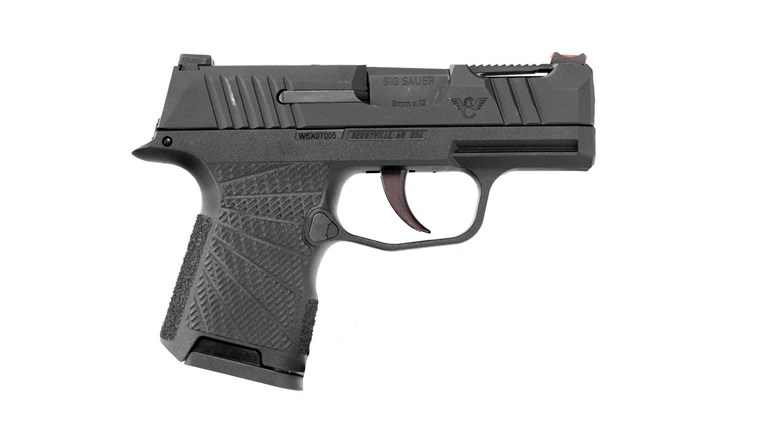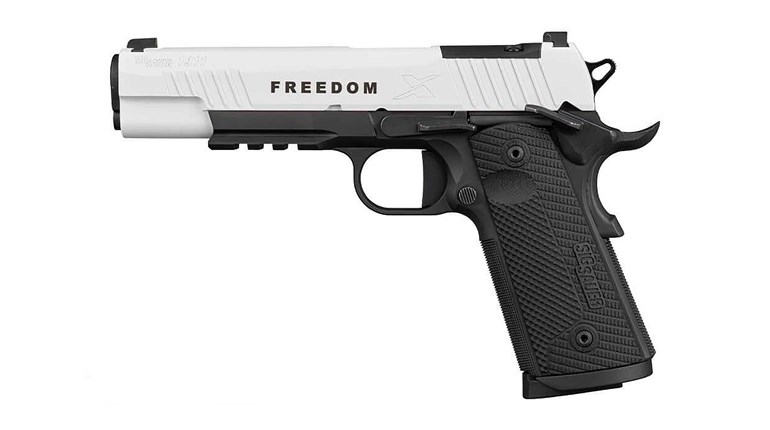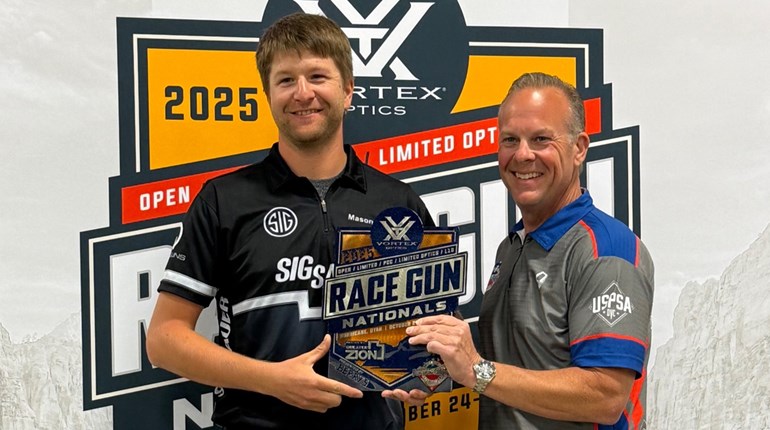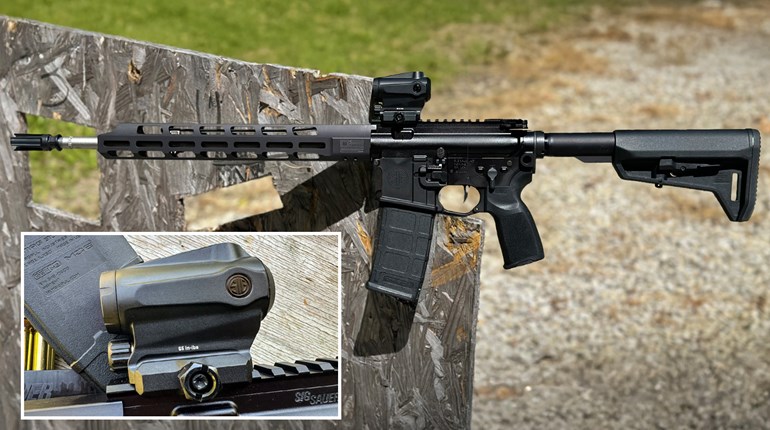
This feature appears in the January ‘18 issue of NRA America’s 1st Freedom, one of the official journals of the National Rifle Association.
It seems odd, in retrospect, that a firearm and cartridge as capable as the SIG P220 and 10 mm Auto took the best part of 35 years to come together. Our alleged niche for the first, after all, includes serious pistoleers of many stripes, and not only of enthusiast temper. In several (other) calibers, accounts of longstanding P220 successes and excellence are not hard to trace back to the mid-1970s.
The 10 mm part of the Legion equation might be somewhat more apropos to that “niche” designation. A talented despoiler—of daunting targets at consequential ranges, but also of handguns chambered for it—the cartridge is the beneficiary of at least three resuscitations. If nothing else, a soundly excellent P220 ought to be a final proof that the caliber is here to stay.

At 41.6 ounces empty, mass alone suggests that the full-sized SIG is up to the substantial energy of its calibration. Sides and rear of the grip are sculpted G10—we would have been slightly more aggressive in texture—but the improved “Elite” beavertail shape, higher trigger guard relief (borrowed from the X-Five p320), and both front strap and trigger guard checkering allow for very secure grasp of the pistol.
These sound handling features and a proprietary Legion Gray finish are mirrored on the slide above. Front and rear cocking serrations are a comparative “must,” as the ultra-rugged, braided wire recoil spring—a SIG hallmark—and hammer spring won’t submit to manipulations with what most would call ease.
These necessities for handling 10 mm power belie an interesting facet of range performance: Ammunition that was delightfully soft-shooting (PPU 180-grain JHPS) ran the Legion capably. Full, new magazines with all their attendant up-pressure on the slide posed no problem, while slide lock on an empty magazine was a 100 percent affair. This reliability extended even to weak-hand shooting. Filtered of jargon, this means we found the P220 comprehensively unparticular about ammunition—rare indeed for a cartridge where factory loads can vary nearly two-fold in power. There was no tendency whatsoever for “good manners” at the high-power end of the spectrum to induce balkiness at the low.
You’d be right to impute superb accuracy, by the way. In good light, one-ragged-hole groups were common between the X-Ray high-visibility sights (complete with tritium lamps) and the very short, crisp take-up on shots after the more challenging first double-action pull (though this went away with practice; see “Nuts And Bolts”).
In the Legion 10 mm, SIG checked off important “gotta haves” for many American shooters, especially for those in search of a powerful autoloader. It’s tempting, too, to leave it there—in many respects, that’s more than enough. But it would also be an injustice: The Legion incarnation of the fabled P220 is a clear advance; a big handgun to be sure, but capable of just-as-outsized performance. Smooth, reliable, elegant and versatile, it’s a pistol we’d confidently, proudly own—and shoot, we expect, for decades to come.
NUTS & BOLTS:
10 mm
Readers might recall we “outed” ourselves long ago as fans of 10 mm, though the whys and wherefores might have faded. A reprise is elementary: There is almost nothing the 10 mm does not do well, and many things it does particularly well—and the P220 proved no exception. It has power in spades, with available energies pushing handily above 700 foot-pounds. “Handily” applies in two senses: Ready in the sense of factory-loaded, and tolerable, specifically, to the hands themselves. We don’t think anyone would prefer full-house .357 Mag. loads to original-spec 10 mm in the Legion; we sure don’t. Superb accuracy—as we and many others have noted—also seems intrinsic.
There is also a lot of current 10 mm ammunition that is of the much-maligned “light” spec that the FBI moved to after brief adoption of the 10 mm in the late 1980s (and which eventually lead to the development of the .40 S&W cartridge). These lighter loads are derided in error, in our opinion. If you want to “let the big dog howl,” Cor-Bon, Federal Trophy Bonded and especially Buffalo Bore will rock you with hunting and defensive options of impressive scale. But for getting the flinch-free hang of a Legion, the light varieties will dwarf standard loads in most other calibers comfortably.
Handloading
Roll-your-own types might be able to lay a greater claim to keeping the 10 mm alive long enough to marry up with the P220 than anyone. We argue that noted SIG guy Bruce Gray (pistolsmith extraordinaire, and contributor of the Legion’s P-SAIT trigger) said it best: “10 mm Auto is still the best cartridge when brute force from a (full)-sized pistol is required,” and that “reduced 10 mm loads can deliver .40 S&W performance with much less pressure, greater safety margins and less wear on the gun.” Enough said.

There is an atypical benefit if you plan on reloading for a Legion of your own: Reliable 10 mm feeding is famously sensitive to overall cartridge length, but we found one setting of our seating die worked with every bullet shape and weight we tried in the P220. It’s darn nice to be able to go from 135- to 220-grain projectiles with nary a fiddle, all the while maintaining flawless function and struggle-free ejection of chambered rounds.
Double Action/Single Action Trigger
As a general matter, we’re hostile to these outside of revolvers, preferring an explicit thumb or trigger-mounted frame safety and learning a single trigger press, in contrast to the argued benefits of the long, heavy—and obviously different—first actuation of DA/SA and a de-cocker as a safety. We must say, though, that the P-SAIT is exceptional. With practice and proper finger position—“more” finger on the trigger face, that is—even the first press becomes rapid and reliable with the typical down and left wobble for righties (down and right for lefties) rapidly fading to undetectability.
Improved trigger function over previous 22X series pistols coalesced in our minds to a final and thoroughly unexpected superiority in the Legion—one-handed shooting performance. Long initial press and high mass may seem strange bedfellows, but they combine with the beavertail shape to give an uncommonly “quiet,” comfortable and therefore accurate single-handed platform (though you may want to raise the thumb to increase web-of-the-hand tension beneath the beavertail). 10 mm power will no doubt make you want both hands on the firearm, but pervasive advances in the Legion P220 mean you won’t absolutely have to. That’s a mighty neat trick, considering all the power the P220 10 mm Legion puts at your disposal.
Frank Winn has been studying arms and their relationship to tyranny, meaningful liberty and personal security all his adult life. He has been a firearms safety/shooting instructor for more than 20 years, and earned state, regional and national titles in several competitive disciplines.


































